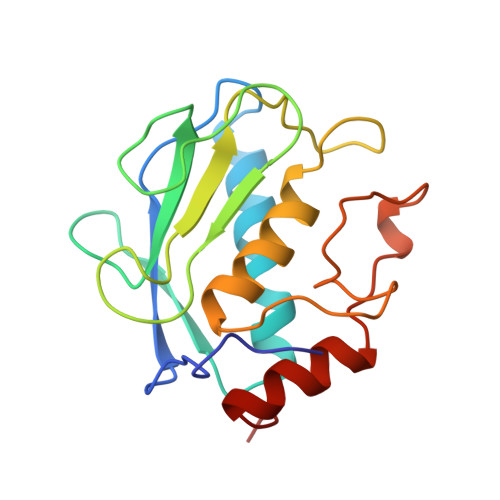X-ray structure of human stromelysin catalytic domain complexed with nonpeptide inhibitors: implications for inhibitor selectivity.
Pavlovsky, A.G., Williams, M.G., Ye, Q.Z., Ortwine, D.F., Purchase II, C.F., White, A.D., Dhanaraj, V., Roth, B.D., Johnson, L.L., Hupe, D., Humblet, C., Blundell, T.L.(1999) Protein Sci 8: 1455-1462
- PubMed: 10422833
- DOI: https://doi.org/10.1110/ps.8.7.1455
- Primary Citation of Related Structures:
1B8Y, 1CAQ, 1CIZ, 1QIA, 1QIC - PubMed Abstract:
Effective inhibitors of matrix metalloproteinases (MMPs), a family of connective tissue-degrading enzymes, could be useful for the treatment of diseases such as cancer, multiple sclerosis, and arthritis. Many of the known MMP inhibitors are derived from peptide substrates, with high potency in vitro but little selectivity among MMPs and poor bioavailability. We have discovered nonpeptidic MMP inhibitors with improved properties, and report here the crystal structures of human stromelysin-1 catalytic domain (SCD) complexed with four of these inhibitors. The structures were determined and refined at resolutions ranging from 1.64 to 2.0 A. Each inhibitor binds in the active site of SCD such that a bulky diphenyl piperidine moiety penetrates a deep, predominantly hydrophobic S'1 pocket. The active site structure of the SCD is similar in all four inhibitor complexes, but differs substantially from the peptide hydroxamate complex, which has a smaller side chain bound in the S'1 pocket. The largest differences occur in the loop forming the "top" of this pocket. The occupation of these nonpeptidic inhibitors in the S'1 pocket provides a structural basis to explain their selectivity among MMPs. An analysis of the unique binding mode predicts structural modifications to design improved MMP inhibitors.
Organizational Affiliation:
Department of Chemistry, Parke-Davis Pharmaceutical Research, Division of Warner-Lambert Company, Ann Arbor, Michigan 48105, USA. Alexander.Pavlovsky@wl.com


















